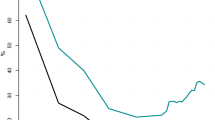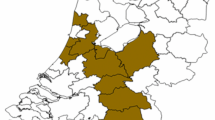Abstract
This article presents a simple model of rent control in which the costs and benefits can be analyzed in terms of Hicksian consumer and producer surpluses. Data from New York City are then used to examine the effect of the long-term rent control in that city. Estimates are presented which suggest that the program provided tenants with benefits amounting to about 5 percent of their income in the years 1965 and 1968. Additional evidence shows that tenant benefits declined rather sharply between the two years, and that in each of the years benefits were higher for older tenants, richer tenants, and white tenants than for their counterparts. Finally, evidence presented here suggests that, due to the in-kind nature of the program, the cost to landlords exceeded the benefits to tenants by about 75 percent.
Similar content being viewed by others
References
DeSalvo, Joseph S. “Reforming Rent Control in New York City: Analysis of Housing Expenditures and Market Rentals.” Regional Science Association Papers and Proceedings 27 (December 1971), 195–227.
Fallis, George and Smith L.B. “Price Effects of Rent Controlled and Uncontrolled Rental Housing in Toronto: a Hedonic Index Approach”. Canadian Journal of Economics 28 (August 1985), 652–659.
—, “Uncontrolled Prices in a Controlled Market: The Case of Rent Controls.” American Economic Review 74 (March 1984), 193–200.
Gyourko, Joseph and Linneman, Peter. “Equity and Efficiency Aspects of Rent Control: An Empirical Study of New York City.” Journal of Urban Economics 26 (July 1989), 54–74.
Linneman, Peter. “The Effect of Rent control on the Distribution of Income Among New York City Renters.” Journal of Urban Economics 22 (1987), 14–34.
Marks, Denton. “The Effect of Rent Control on the Price of Rental Housing: An Hedonic Approach.” Land Economics 60 (February 1984), 81–94.
Moorhouse, John C. and Elavia, Tony H. “The Effects of Selective Decontrol in the New York City Rental Housing Market.” Atlantic Economic Journal 15 (July 1987), 11–24.
Niebanck, Paul L. Rent Control and the Rental Housing Market: New York City 1968. New York: City of New York, 1970.
Olsen, Edgar O. “An Economic Analysis of Rent Control.” The Journal of Political Economy 81 (November/December 1972), 1081–1100.
-Olsen, Edgar O. and Barton, David. The Benefits and Costs of Public Housing in New York City. Discussion Paper 111, The Thomas Jefferson Center for Political Economy, University of Virginia, 1982.
Roistacher, Elizabeth A. “The Distribution of Tenant Benefits under Rent Control.” Ph.D. Dissertation, University of Pennsylvania, 1972.
Rydell, C. Peter, et al. The Impact of Rent Control on the Los Angeles Housing Market. Santa Monica, CA: Rand Corporation, 1981.
Vitaliano, Donald F. “Measuring the Efficiency Cost of Rent Control.” A.R.E.U.E.A. Journal 14 (1986), 61–71.
Author information
Authors and Affiliations
Rights and permissions
About this article
Cite this article
Ault, R., Saba, R. The economic effects of long-term rent control: The case of New York City. J Real Estate Finan Econ 3, 25–41 (1990). https://doi.org/10.1007/BF00153704
Issue Date:
DOI: https://doi.org/10.1007/BF00153704




